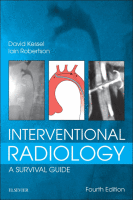Physical Address
304 North Cardinal St.
Dorchester Center, MA 02124

Percutaneous placement of inferior vena cava (IVC) filters and treatment of superior vena cava obstruction (SVCO) ( Ch. 44 ) are the cornerstones of venous intervention. Venous angioplasty, stenting and thrombolysis are sometimes performed but remain controversial techniques, except in…

Referrals for management of vascular access problems are among the most common requests for vascular intervention in centres where haemodialysis is performed. Tip Embrace the dialysis patients; they will be one of the most important training grounds for vascular access,…

If you practice vascular intervention you will find yourself called to stop haemorrhage. This is one of the most challenging and rewarding aspects of practice and frequently life-saving. There are three ways you can help: Inflow occlusion balloon: this is…

Aneurysms can affect vessels of any size. Clearly, not every aneurysm requires immediate treatment but, when indicated, successful endovascular management requires exclusion of the aneurysm from the circulation. The main options can broadly be thought of as: Embolization techniques which…

Acute limb ischaemia describes a sudden reduction in perfusion of <3 days' duration. The ischaemia is usually due to thrombosis in native arteries or bypass grafts secondary to an underlying stenotic lesion. The severity of ischaemia is categorized using the…

Angioplasty and stenting are cornerstone techniques in interventional radiology and have widespread non-vascular and vascular applications. The key skills and equipment choices remain largely the same, regardless of the site. This chapter assumes that you have already mastered the theory…

Having a high-quality route map of the target vascular bed and, if necessary, the access to it are the keys to successful vascular intervention. They determine the choice of approach, the best equipment to use and the suitability for intervention.…

Treating tumours Understanding ablative techniques The objectives of tumour ablation are to increase patient survival and sometimes to palliate local symptoms and painful tumours. There are several techniques which cause either tissue heating (radiofrequency [RF], microwave, laser, focused ultrasound) or…

Biliary intervention mainly involves biliary drainage and stent insertion. Magnetic resonance cholangiopancreatography (MRCP) and Computed tomography (CT) are the primary tools to investigate stones or other bile duct abnormalities and will usually determine the site and nature of biliary obstruction.…

Gastrointestinal interventions fall into two main groups: establishing enteral access for feeding and stenting to treat obstruction secondary to malignancy. Nasogastric/nasojejunal tubes Most nasogastric tubes are placed on the ward and most nasojejunal tubes are placed by endoscopists. If a…